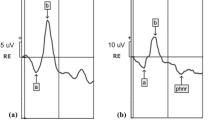Abstract
Clinical findings and results of electrophysiologic evaluation of the visual pathway were studied in seven children ranging in age from 10 months to 13 years. Using skin electrodes for electroretinographic and visual evoked potential testing, we obtained reliable results without sedation or pupil dilation. The half-field stimulation was indispensable for localizing lesions along the visual pathway and thus for specific diagnosis.
Similar content being viewed by others
Abbreviations
- CT:
-
computed tomography
References
Apkarian P, Spekreijse H. The use of the electroretinogram and visual evoked potentials in ophthalmogenetics. In: Desmedt JE, ed. Visual evoked potentials. Amsterdam: Elsevier Science Publishers, 1990: 169–223.
Fulton AB, Hartmann EE, Hansen RM. Electrophysiologic testing techniques for children. Doc Ophthalmol 1989; 71: 341–54.
Moskowitz A, Sokol S. Developmental changes in the human visual system as reflected by the latency of the pattern reversal VEP. Electroencephalogr Clin Neurophysiol 1983; 56: 1–15.
Chiappa KH. Evoked potentials in clinical medicine. 2nd ed. New York: Raven Press, 1991.
Sokol S. Abnormal evoked potential latencies in amblyopia. Br J Ophthalmol 1983; 67: 310–4.
Brecelj J. Visual evoked potentials and the localization of visual pathway lesions. Spektrum Augenheilkd 1991; 5: 114–22.
Halliday AM. The value of half-field stimulation in clinical visual evoked potential testing. In: Morocutti C, Rizzo PA, eds. Evoked potentials. Neurophysiological and clinical aspects. Amsterdam: Elsevier Science Publishers, 1985: 293–313.
Harbord MG, Lambert SR, Kriss A, Brett EM, Baraister M, Supramaniam G. Autosomal recessive microcephaly, mental retardation with nonpigmentary retinopathy and a distinctive electroretinogram. Neuropediatrics 1989; 20: 139–41.
Russell-Eggitt I, Kriss A, Taylor DSI. Albinism in childhood: a flash VEP and ERG study. Br J Ophthalmol 1990; 74: 136–40.
Groswasser Z, Kriss A, Halliday AM, McDonald WI. Pattern- and flash-evoked potentials in the assessment and management of optic nerve gliomas. J Neurol Neurosurg Psychiatry 1985; 48: 1125–34.
Kriss A, Timms C, Elston J, Taylor D. Pattern- and flash-evoked potentials in patients with dissociated vertical deviation. Doc Ophthalmol 1988; 69: 283–91.
Author information
Authors and Affiliations
Rights and permissions
About this article
Cite this article
Brecelj, J., Stirn-Kranjc, B. Electrophysiologic evaluation of the visual pathway in children. Doc Ophthalmol 79, 313–323 (1992). https://doi.org/10.1007/BF00160946
Accepted:
Issue Date:
DOI: https://doi.org/10.1007/BF00160946




